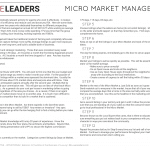Most firms don’t fail for lack of talent. They fail for lack of operating discipline. If your revenue, recruiting, and margins swing with market cycles or one rainmaker’s output, you don’t have scalability—you have exposure. A brokerage operating system is the institutional muscle that removes heroics, aligns decision-making, and turns performance into a repeatable, auditable process.
At RE Luxe Leaders® (RELL™), we see the same pattern across elite firms: once leaders formalize a brokerage operating system, growth becomes controlled, margins stabilize, and leadership gains time back. What follows are the non-negotiables—built for operators serious about durability, not noise.
1) Strategy Cadence and the KPI Stack
Strategy without cadence is theater. Establish a clear planning rhythm—annual strategic priorities, quarterly execution plans, monthly financial reviews, weekly operating reviews—and a KPI stack that ties each layer to unit economics. At minimum, leaders should review: pipeline coverage (by line of business), contribution margin by cohort (agent, office, or team), recruiting funnel velocity, and tech utilization by function. Decide in advance what gets measured, the decision threshold that triggers action, and who owns that action.
High-performing organizations use a fast drumbeat to de-risk decisions and shorten feedback loops. As McKinsey notes, disciplined, rapid cycles lift execution quality and responsiveness (The drumbeat of agile).
Move now: set the annual plan in one page (objectives, constraints, capital allocation), define quarterly targets, and lock a weekly operating review that holds revenue, recruiting, and margin accountable to leading indicators.
2) Revenue Engine and Pipeline Quality
Volume is not a strategy; quality is. Your brokerage operating system must standardize definitions for lead, opportunity, and forecast stages across lines of business (agent recruitment, developer services, institutional accounts, referral partnerships). Forecasts should be probability-weighted, auditable, and aligned to cycle time benchmarks. Track channel ROI (events, referrals, brand marketing, recruiting campaigns) with payback periods and cut rules for underperformers.
Pipeline integrity depends on a common taxonomy and enforcement. Require evidence at each stage (contract out, financials in, decision authority confirmed) and instrument stage conversion. Set minimum 3x to 4x pipeline coverage for the next two quarters; adjust by cycle length and hit rate. Eliminate unqualified optimism—use hard disqualification criteria.
Deloitte continues to flag operational discipline and cost control as differentiators in a tighter capital environment (2024 Commercial Real Estate Outlook). Treat your revenue engine like a portfolio: reallocate to channels with highest risk-adjusted returns.
Move now: implement stage definitions, require evidence-based forecasting, and publish a weekly revenue scorecard covering coverage ratio, cycle time, win rate, and net new opportunities by source.
3) Talent Architecture and Capacity Planning
Talent design is an operating choice, not HR paperwork. Define role scorecards for revenue, enablement, operations, and finance, with measurable outcomes per role. Codify spans of control (e.g., manager-to-agent ratio), eliminate player-coach overload, and instrument ramp times for new hires. Compensation should align to contribution margin and controllable levers, not vanity volume.
Capacity planning is simple: forecast workload by unit (onboardings, transactions, listings launched, recruiting interviews) and match to capacity at a defined service level. If you consistently miss deadlines, you’re under-resourced or misaligned; if your managers spend >40% of time firefighting, you have decision-rights confusion or broken process downstream.
Move now: publish scorecards for each role, set a 12-month hiring plan tied to forecasted demand, and implement a 90-day ramp playbook for every revenue and operations role.
4) Operating Rhythm, Decision Rights, and Escalation
Meetings are part of the machine, not the machine. Lock a weekly business review (WBR) with a fixed agenda: revenue (pipeline and forecast delta to plan), recruiting (funnel and time-to-offer), productivity (by cohort), and margin (by line of business). Use a decision log to record what was decided, by whom, and with what trigger. Define escalation paths: what goes to the WBR, what escalates to monthly leadership, and what stays at the functional level.
Decision rights remove friction. If everything requires the top of the org, you built a slow company. Clarify who has final call on pricing exceptions, compensation adjustments, headcount adds, and tech purchases, with thresholds tied to financial impact. The operating rhythm is the spine of your brokerage operating system—protect it from drift.
Move now: publish the WBR agenda, implement a decision log, and document decision-right owners with thresholds. Enforce start/stop times and pre-read requirements.
5) Financial Model and Unit Economics
Strategy is resource allocation under constraint. Build a full-funnel model by line of business that connects acquisition cost to contribution margin and cash payback. Track: CAC per agent recruited, payback period (months to net-positive contribution), contribution margin by agent cohort/office, tech spend as a % of GCI with target ROI, and SG&A per transaction with glidepath to target.
Expect margin compression and plan accordingly. PwC’s annual industry review underscores persistent pressure on cost structures and the premium on operational excellence (Emerging Trends in Real Estate 2024). Your counter is ruthless clarity on what creates economic value—and hard cuts on what does not.
Move now: implement rolling 13-week cash forecasts, monthly contribution-margin by cohort, and a quarterly capital allocation review that reassigns budget to the highest-return initiatives.
6) Data Architecture, Controls, and Visibility
Without a single source of truth, you’re optimizing anecdotes. Define a data dictionary for core entities (agent, opportunity, listing, deal, expense), standardize field names, and enforce required fields at capture. Integrate your CRM, recruiting ATS, transaction management, and accounting into a governed warehouse. Build role-based dashboards: leadership (P&L, pipeline, margin), revenue (coverage, cycle, win rate), recruiting (funnel, time-to-offer, ramp), and operations (SLA attainment, error rates).
Controls matter. Restrict manual overrides, log changes, and audit quarterly. Own your integrations—don’t let vendor sprawl dictate your operating logic. The outcome is decision-grade visibility and faster cycle times across the firm’s brokerage operating system.
Move now: publish the data dictionary, select the integration path (iPaaS or native), and deploy a leadership dashboard that refreshes daily and aligns 1:1 with the KPI stack.
Execution Notes and Adoption
Adoption is a leadership issue, not a training task. Roll out the operating system in sprints: codify the KPI stack and WBR first, then revenue engine definitions, then data standardization. Incent behavior by tying compensation or bonuses to system-compliant performance (e.g., forecast accuracy, SLA attainment). Conduct quarterly post-mortems on misses and adjust the system—not just the team.
If you want outside pressure and speed to execution, use a third-party operator to run the first 90 days and hand you a working cadence. That’s how we compress time-to-value with clients at RE Luxe Leaders®—clear design, controlled rollout, measurable lift.
Conclusion: Build a Firm That Outlasts You
Markets will normalize; expectations will not. Firms that institutionalize strategy cadence, revenue integrity, talent design, operating rhythm, unit economics, and data governance will out-execute and outlast. A brokerage operating system is not a software stack. It is the disciplined way your firm plans, sells, hires, measures, and decides—independent of any one person or cycle.
If you’re ready to replace improvisation with institutional strength, move now.





